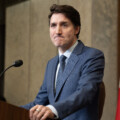A few weeks ago, I asked Conservative Party leader Pierre Poilievre why he thought the Trudeau government had opened up immigration so dramatically in the aftermath of the pandemic. His best hypothesis was that the government was responding to businesses who wanted to drive up labour competition and drive down wages. It’s a classic public choice story.
Poilievre’s answer brought me back to one of Canada’s most important political economy books in recent decades, Brian Lee Crowley’s 2009 book, Fearful Symmetry: The Fall and Rise of Canada’s Founding Values. (Full transparency: I was Crowley’s research assistant for the book.)
His audacious thesis was that the previous four or five decades of Canadian policy and politics were best understood through the interaction between the rise of Quebec nationalism and the demographic dominance of the Baby Boom generation. The book then speculated on what might happen as these key cultural and demographic forces fell into secular decline.
From a labour market point of view, Crowley’s key insight was that Canada’s Baby Boom—one of the largest in the industrialized world—created a structural imbalance between labour supply and demand for the better part of four decades. The consequence was to strengthen the relative bargaining power of employers, put downward pressure on wages, and raise the floor of unemployment.
One may not have liked these outcomes, but the supply-demand gap behind them was natural. It wasn’t the consequence of nefarious businesses or distortionary policies. Government policy, in fact, as Crowley set out, was consumed (perhaps too much) by managing the effects of a labour market equilibrium rooted in fertility rates that produced a lot of joblessness.
The aging of the Baby Boomers, including their withdrawal from the workforce, comes with pluses and minuses. It’s well documented, for instance, that it will put significant pressure on government budgets as the inexorable demand for public pensions and health care rises. On the other hand, one of the anticipated upsides is that it should reset the structural imbalance at the heart of Canada’s labour market. If natural labour market growth was behind it, then, ostensibly, its demographic inversion would reverse it.
The effect would be for the asymmetry between businesses and workers to tilt in favour of the latter, who would now have more employment options and, in turn, could demand higher wages and other benefits. It would also shift the incentives for businesses to invest more in capital, especially labour-substituting technologies, which could boost Canadian productivity.
Crowley anticipated that these trends would have major and mostly positive consequences on Canadian policy and politics. In particular, he envisioned a positive-sum future where work and its material and non-material benefits would be essentially available to anyone who wanted them.









